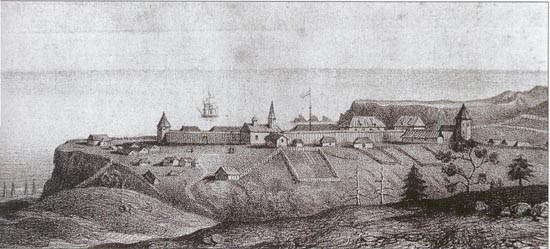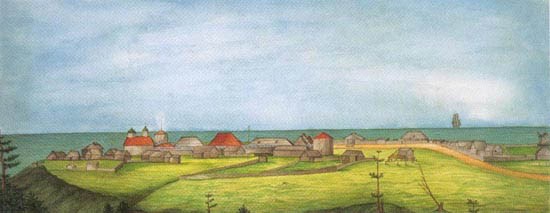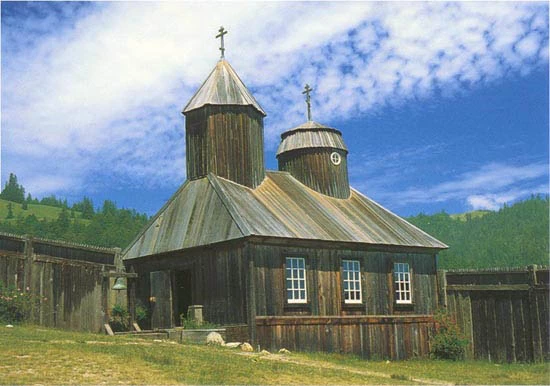
Courtesy of Fort Ross Historic Park Archives, California State Parks
Fort Ross Chapel
Jenner, CA
Designated an NHL: October 8, 1969
Designation withdrawn: December 7, 1971*
*This is when the property was removed from the National Register of Historic Places. A formal dedesignation process for NHLs was created in 1980. Before then, a property that no longer met NHL criteria was simply removed from the official list.
Fort Ross, founded in 1812 by the Russian-American Company, was primarily a commercial settlement; sea otters were trapped for their pelts and farming was undertaken here to support Russian colonies in Alaska. As Ross grew, the local Kashaya people worked for the Company and some Russian men married Kashaya women. The population became a mixture of Russians, Native Americans, and Creole inhabitants, as was the case at other Russian colonies in North America. In the 1820s, company employees began planning a chapel dedicated to Saint Nicholas; this log chapel, built on the Russian quadrilateral plan, was probably constructed in 1825. The Russian settlement lasted until 1841, becoming the southernmost limit of Russian colonization in North America.
Numerous Russian companies sponsored hunting and trading voyages to the Aleutian Islands and mainland Alaska beginning in the 1740s. The Russian-American Company became the undisputed master of Russian commercial activities and settlements in North America in 1799, however, when it was sanctioned by a charter from the Tzar. With shares held by members of the nobility and government officials, the joint-stock company functioned virtually as a government appendage.
Ivan Alexandrovich Kuskov, assistant to the Company's manager, was sent on exploratory missions to scout possible settlement sites in California beginning in 1808. In 1811 he located a promising cove and point north of Bodega Bay on the Sonoma Coast; the native inhabitants of the area, the Kashaya Pomo people, were amenable to the Russian settlement. With twenty-five Russians and eighty native Alaskans, Kuskov returned to this site in March of 1812 and established the settlement. Completion of the stockade on August 30th was formally marked by a religious ceremony.
The plan for a chapel dedicated to Saint Nicholas was assisted by donations from the personnel of three Russian navy ships in 1823-24. Four icons for the chapel were soon ordered and the chapel was probably constructed about 1825. The "newly built chapel" was first mentioned in writing by Auguste Bernard Duhaut-Cilly, a French visitor, in 1828. In 1832 a visiting Bostonian described the situation of the chapel within the stockade: "The Presidio is formed by the houses fronting inwards, making a large square, surrounded by a high fence. The Governor's house stands at the head, and the remainder of the square is formed by the chapel, magazine, and dwelling houses. The buildings are from 15 to 20 feet high; built of large timbers, and have a weather-beaten appearance."

Courtesy of Peter the Great Museum of Anthropology and Ethnography, Russian Academy of Science
In the late 1830s, the Russian-American Company decided to rid itself of its colony at Ross. The agricultural output of the settlement was poor; stock-raising was attempted but not as successful as hoped; and the population of sea otters had been depleted. In addition, settlements by Mexicans and Americans created a challenge to tenuous Russian land claims. The Company offered its Ross holdings for sale in 1840, but proposals to the Hudson's Bay Company, the French and Mexican governments were all declined. In December 1841, the settlement was sold to Captain John Sutter. The transaction included all the buildings and property, but not the land itself which Mexico claimed.
The Fort Ross complex operated as a rancho from 1841 to 1867, under the ownership of John Sutter and William Benitz. From 1867 to 1873, Ross was part of a logging business. In 1873, George Washington Call purchased Ross and eventually 7,000 adjoining acres. During the ownership by the Call family, which lasted until 1903, Ross was used as a ranch port and social center. Some of the fort buildings housed a hotel, a dance hall, and a saloon. The chapel was used for various purposes - sometimes for functions such as weddings, but at other times, apparently for sheltering horses or storing produce.

Courtesy of Fort Ross Historic Park Archives, California State Parks
In 1903, George Call sold 2-½ acres containing Fort Ross to the California Historical Landmarks League. The property was donated by this organization to the State of California in 1906 for preservation and restoration. A few months later, however, an earthquake caused the chapel to collapse but left the roof and its two towers virtually intact. The State restored the Chapel between 1915 and 1917; it was later discovered that mistakes had been made during the restoration. Most of the earlier errors in restoration were fixed during repairs undertaken from 1955 to 1957.
The Fort Ross Chapel was found eligible for designation as a National Historic Landmark in 1969, architecturally significant as a rare U.S. example of a log church constructed on a Russian quadrilateral plan. An accidental fire destroyed the chapel on October 5, 1970. This loss of the original workmanship and materials of the chapel led to withdrawal of the Chapel's Landmark designation in 1971. A complete reconstruction of the chapel was undertaken in 1973 and the Fort Ross settlement, as a whole, retains its National Historic Landmark designation.

Courtesy of Fort Ross Historic Park Archives, California State Parks
Last updated: August 29, 2018
